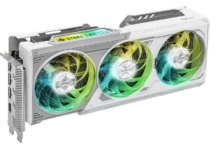We have taken the most fearsome video cards on the market and given them to the world’s best 3DMark overclocker. Going from extreme air cooling to liquid nitrogen Kinc shows how you treat ATI and NVIDIA’s babies if your a serious overclocker.
At the beginning of October ATI launched a new series of video cards with Radeon X1800XT as the performance monster leading the new generation. About the same time that the cards would be released in the middle of November NVIDIA relased without warning a the least to say tuned 7800GTX card. Even if they still used the GTX name, although with the 512 addition to tell you of the larger amount of memory, you could historically call this new version an Ultra version. With just as much memory used by both cards and with NVIDIA’s increased frequencies the situation has never been so even.
Usually we don’t talk about the overclocking until the end of our articles, but this time thought we would do the exact opposite. We usually test the cards with the stock cooler, but we thought we would change that. Therefore we hired Marcus Hultin, also known as Kinc and world record holder in all three 3DMark categories. He will with the help of dry ice and liquid nitrogen investigate what X1800XT and 7800GTX 512 can do under extreme conditions.
Let’s take a look at the test system and how we have planned the tests
 | |
Test system | |
| Hardware | |
| Motherboard | DFI LANParty UT nF4 |
| Processor | AMD
FX-57 (San Diego, 0512UPMW) |
| Memory | Corsair TwinX 2x512Mb (BH-5) |
| Video cards | ATI Radeon X1800XT nVidia 7800GTX 512 nVidia 7800GTX |
| Power supply | OCZ PowerStream 600W Silverstone ST65ZF 650W |
| Software | |
| Operating system | Windows XP (SP2) Windows 2000 SP4 |
| Drivers | nForce 6.70 Catalyst 8.173 Catalyst 5.10a ForceWare XX.XX |
| Benchmarking program | 3DMark2001 (3.3.0) 3DMark03 (3.6.0) 3DMark05 (1.2.0) |
We will, as you can see, focus on the 3DMark applications to see exactly how much of a difference there is between the cards and how the overclocking affects the results.
First up is overclocking with the X1800XT card.
Moving forward with care is very important when overclocking. It may seem that it takes no time at all to raise the frequencies and face a complete 3DMark run, which is far from the reality. All cards clock differently and reacts different to cold and voltage and it is therefore an advantage to begin with some air cooling. Here you see a conclusion of how far we could go before turning to dry ice and liquid nitrogen.
Foreplay – ATI Radeon X1800XT |
||
| Cooling | Core (MHz) | Memory (MHz) |
| Stock cooling, default voltage | 658 | 841 |
| Zalman air cooling + memory heatsinks | 740 (1.50vgpu) | 920 (2.0vddr/2.2vio) |
During these runs we used varying processor frequencies, but to mention a few figures we passed 44500 in 3DMark2001 (FX-57 with 3750MHz) and 11000 in 3DMark05 (FX-57 with 3120MHz).
Next up is the more extreme cooling.
Before running the card cooled with dry ice and liquid nitrogen you have to prepare the card much more carefully and here you can see some examples of how the cards were prepared. We decided to start with investigating how the card reacted to cold by carefully dosing it with liquid nitrogen while running 3DMark. The card had no problems with the low temperatures and we could lower it all the way down to -60C. Here we managed to push the card all the way up to about 840MHz at the core and 920MHz at the memory.
Here we see the cooling effect already at small doses of liquid nitrogen. The card is covered with a thin layer of grease to stop moisture from creeping in under the components and causing problems. The last picture shows how it may look when a bunch of pipelines doesn’t want to play along. Unfortunately we experienced that effect more often than not during our tests. Alas drying and setting up the card again for a new run takes a very long time. As long as the card worked fine we focused on 3DMark05 and here is the result of the processor running at 3XXX and the video card at 840MHz at the core and 920MHz at memory.
Next card is nVidia 7800GTX 512MB.
When things aren’t going where you want them to it is always nice to be able to return to the air cooling instead to slow things down. The working environment gets a bit more unbearable, with the level of noise from these fans ear protection is a given. This is far from a high priority though. Since you don’t have to work under the same pressured schedule with air cooling as you do with liquid nitrogen the work is much more simple. You do a safe run and then set a new goal from that, as high as possible but still realistic. After a couple of runs I decided set the goal to an even 11000 points. To be honest we should have done it all the other way around. Running max on air first and then move over to extreme cold. But with the tight schedule we had we didn’t get the opportunity to do this. Even if there were coldbugs which was our biggest problem the results with the extreme cooling would have looked more impressive if we would have had more time.
The stock cooler X1800XT uses is rigorous with a lot of mass and contact surface. But however you can’t use additional fans for cooling. We therefore used a Zalman CF700-Cu cooler and the heatsinks that comes with it to cool the memories. The fan you see on the picture is normally used to ventilate separate rooms such s bathrooms in houses.
After we lost count on how many runs we had done we finally found a good balanced and stable frequency with both GPU and memory. 740MHz core and ~900MHz on the memories. Finally, after many runs with small increases for each run we reached 11007 points with the memories running at 920MHz. No big margin, but we reached our goal at 11k.
Volt modifications sounds more complicated than they really are. What you first of all have to be aware of is that you loose any warranty you might have and that there of course is a risk that the card will break. If you aim to modify your card for use in a regular 24/7 computer i sincerely ask you to reconsider. There is a risk that the resistors we use will break and will make the card’s vreg deliver extremely high voltages.
Basic soldering knowledge is a must. If you’re used to working with electronics you will be just fine. A big plus is if you have anything similar to practice with first. I started directly with a X850XT without practice, something i really regret (lets just say I was lucky that I didn’t break anything). What you need to modify a GTX512 (or 256):
:: 1 floppy- or regular ATA cable
:: 1 200 ohm trim potentiometer for modifying the voltage to the gpu
:: 1 100 kohm trim potentiometer for modifying the voltage to the memory
:: 15W soldering iron with a small tip
:: Thin solder for electronics
I suspect that you, just as I, has had no use for the floppy cable that came with the motherboard. The cables for the individual poles are very good for what we are suppose to do though. Begin with separating six cables. Strip them of about 2mm isolation on both sides. Since these cables wasn’t meant to be stripped you need to heat the ends so that the plastic contracts. Then cut down to 2mm stripped cable. Then its time to bring out the solder which I hope you haven’t cheaped out on. When melted you get a small drop on the tip, apply a small amount on the cable. Certain unused soldering points might be treated, then it helps by heating the point a little before attaching the cable. Place the cable against the soldering point and heat (against the thread) until the solder is attached to the soldering point. Then release carefully. Repeat for all spots. The ground is easily fetched from the filter capacitors which you can fix with some extra solder. Same goes for the measuring points.
 |
We continue as we did with the XT card to see what it would be able to pull off with the stock cooler. With nVidia’s card you don’t have the option of changing the voltages through software which you can with ATI’s latest generation, we therefore had to do some good ol’ mods with trim pots.
As we showed you in the preview of XFX 7800GTX 512MB it performed over 10 000 with 3DMark 05 at the default frequencies (both gpu and memory). But we also saw that you could overclock quite much with the stock cooler. 638 MHz core and 1938MHz memory is considerably more than I had expected as GTX512 is pretty much a tweaked GTX256. However it seems that GTX512 has a core that was intended for a 7800Ultra card, which is capable of much higher frequencies.
Overclocking using air cooling is a delight with GTX512. The stock cooler is sturdy and can easily be improved with some alternative fans. At 630MHz we hit a wall as the default voltage didn’t allow us to move any further.
Foreplay – nVidia Geforce 7800GTX 512MB |
||
| Cooling | Core (MHz) | Memory (MHz) |
| Stock cooling, default voltage | 630 | 970 |
| Stock cooling, modified GPU-voltage | 682 (1.65V) | 970 |
The process of LN2 isn’t fun, a real pain to be honest. We started of with a positive response as the card showed already at a few negative degrees a big increase in frequency. The sad part is that the card hits a coldbug already at -20C. When we continue past -20C the screen becomes nothing else but crap. Colder than -30C the system doesn’t even post. In Windows and 3D the card handles -50 before it starts to shows signs of loss of performance and artefacts. Although the card didn’t clock the least bit better with lower temperatures than -40C. This means that the card is a nightmare to run with LN2. Dry ice isn’t even an option. However not all cards are as bad as this one. We have seen three other XFX 7800GTX 512MB cards work just fine at these temperature. With some luck, in the future, we hope to be able to get a hold of two cards that likes cold. Some time after these tests were done I ran some tests with two other GTX512 using liquid nitrogen. Both handled -120C and about 800MHz core with 2100MHz memory. After -80 the overclocking potential doesn’t change however. But with a buffer of 40 degrees LN2 becomes quite a simple process. You will be able to read more about this at the end of the month.
The results with liquid nitrogen are because of this pretty poor. The processor wasn’t run at very high speeds because we had earlier installed .Net when we ran X1800XT and it screws up the stability completely. Even when it is removed we get the same type of instability when going above 3800MHz. The processor has little effect on the performance with 05 with a single video card however.
When we later was about to try out the card with the stock cooler we unfortunately got a negative response as the card refused to play along. The screen just showed as crap at startup. We have theories of what could have happened to the card. The first is that the card has simply been damaged by the cold, with a coldbug already at -20C it’s not unlikely that the gpu has been damaged. The other is that the memory has been damaged by the high temperatures without heatsinks. Normally the cold which spreads through the PCB is more than enough. When the heat dissipation is this high this doesn’t seem to be enough.
That things break when you benchmark is quite common. There is a lot of things that can happen; condensation, broken vregs, overheating, a trimpot breaks and raise the vcore to 3V is common. More rare reasons are dropping a fan on the motherboard which cuts off the capacitors or other vulnerable components. So far all capacitors are intact, the situation for DFI:s “on board” power-on button is a bit worse however, which apparently can be cut off by doing just that. Me and Robert can assure you that a delta 60 fan can cause tremendous damage to memory modules as well. But most of the time you are amazed over how much beating the hardware can take. A good example are my XFX 7800 GTX256 card which can handle up to 3V and can run at about 1800MHz. 1.6ns GDDR3 chip which behaves as BH-5. Things like these feels like they are just too good to be true. Just as when BH-5 became common knowledge and people started torture them with voltage. I don’t think that many back in those days would believe that today people feed their BH-5 with 3.7V. You have to take chances to make progress as a benchmarker and overclocker.
This case extra tough as this was one of the few 7800GTX 512MB cards available in Sweden at the moment, the price tag at about 8000 SEK didn’t exactly make it easier. I hope I won’t have to experience a dead card available only in limited numbers ever again.
As luck has it we had an extra 7800GTX 512MB lying around. A reference card from NVIDIA. Since the results with liquid nitrogen was a big disappointment because of coldbugs we decided to max out the card with air cooling. –NVIDIA, I promise I won’t voltmod the card 🙂. I packed my bag with the rig and headed 200 km north to get as good air cooling environment as possible.
Overclocking with air requires patience as the video card can easily be damaged by the higher voltages, which in turn creates more heat. Artefacts are to be considered extra carefully when using air cooling. The default voltage is as mentioned before 1.5V. My earlier experiences from GTX256 I feel safe to begin at 1.6V. Here the card makes a significant increase up to 667MHz. Further increase didn’t add much and I chose to settle at 1.65V which gives me a frequency of 681MHz. This is at a room temperature of 15°C, with colder air I feel confident to be able to reach 700MHz. The memory reached a whopping 2000MHz without any voltage modifications.
To get some more out of the system I put on my skiing overalls and open to create a draft across the room. The room temperature ends up at a little below 0C. 15C degrees less lets me go up to 690 with the same voltage. Going up to 1.72V the card manages 702 MHz.
The result at 12103 is high, very high. If we compare it to Shamino’s WR with a single GTX256 he used a cascade on both cpu and video card to reach 11900 points. Macci has also used dry ice with a Dothan and a X1800XT to reach ~ 11800. 3DMark 01 was of course a must since I have been running 3DMark01 for long on air and have longed for reaching 40k with a single card. I never gave it an honest try with GTX256, but 40k is most likely possible with such a card as well. GTX512 did it with a wide margin. A whopping 42 827 running on only air is huge if we compare to what things looked like only six months ago.
The comparisons above are very interesting. Here we among others see how old 3DMark 01 really is. The SLI comparison to the left speaks for itself.
With an entire weekend with curses and an endless stream of problems I feel pretty good about this. It’s not as fun as when things don’t break, but then again you do learn something from it. Unfortunately this happened this time and a GTX512 card broke, but worse things can happen and believe it or not, that is exactly how it feels and has to feel to keep you going and not make you give up forever. As long as you feel this way you can always come back with more energy and better results. We did manage with some really impressive results with air cooling and If you ask me (Kinc) I prefer air cooling at all times, as it’s the small things that counts. When it comes to knowledge it just feels like you gain more from it.
After the intensity from the benchmarking sessions has settled you start to look around and actually notice the workspace where you’ve been spending most of your time the last couple of days. Many would say that it was far from pretty, chaos is another word.
:: Download a movie of the chaos (4.85MB)
From this little corridor we wish you good health and until we meet again, take care!

















































